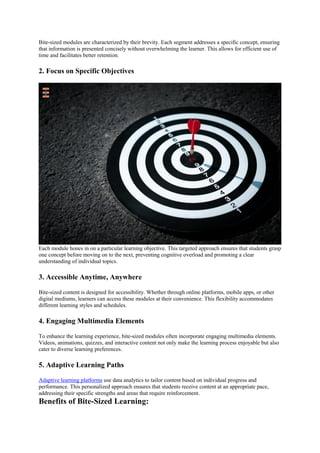How to Measure the Impact of Bite-Sized Learning: Strategies and Proven Results
Bite-sized learning—also known as microlearning—has become a powerful tool in today’s fast-paced work environments. But as organizations invest more into microlearning programs,a pressing question arises: How can you accurately measure the impact of bite-sized learning? In this complete guide,we’ll explore effective strategies,proven results,and practical tips to help you track and optimize the effectiveness of your bite-sized learning initiatives.
Understanding Bite-Sized Learning
Before measuring impact, it’s crucial to understand what bite-sized learning is.Bite-sized learning breaks information into small, digestible modules—usually between two to ten minutes each. Delivered through digital platforms, these modules focus on one key topic or skill at a time, increasing knowledge retention and engagement.
- Short, focused lessons
- Accessible anytime, anywhere
- Perfect for busy learners
- Works well for just-in-time learning needs
The Benefits of Measuring Bite-Sized Learning
Assessing the impact of bite-sized learning is vital for several reasons:
- Proves ROI (Return on Investment): Showcases the effectiveness of your microlearning strategy.
- Enables Continuous Improvement: Data-driven insights help you refine content and delivery.
- justifies Further Investment: Accurate measurement provides stakeholders with concrete results.
- Enhances Learner Engagement: Validates what’s working and uncovers new engagement opportunities.
Key Metrics for Measuring Bite-Sized Learning Impact
To effectively measure the impact of microlearning, focus on these vital metrics:
1.Completion Rates
- track how many learners finish each module.
- High completion rates frequently enough indicate strong engagement.
2. knowledge Retention Scores
- Assess learning through quizzes, micro-assessments, and follow-up tests.
- Compare pre- and post-training results to measure improvement.
3. Application on the Job
- evaluate observable changes in workplace behavior or skills application.
- Gather manager and peer feedback on performance improvements.
4. Learner Feedback & Satisfaction
- Survey learners on content relevance, clarity, and overall satisfaction.
- Track Net Promoter Score (NPS) for microlearning experiences.
5. Performance Metrics & Business KPIs
- Connect learning outcomes to real business results (e.g., sales, productivity, error reduction).
- Align with specific goals and objectives for accurate impact assessment.
💡 Tip: Use a mix of quantitative (scores, rates) and qualitative (feedback, interviews) data for a holistic view of microlearning impact!
Proven Strategies to Measure Bite-Sized Learning Effectively
-
Set Clear, Measurable learning objectives
define what success looks like before launching a bite-sized learning program. Ensure each microlearning module has SMART objectives (Specific, Measurable, Achievable, Relevant, Time-bound).
-
Incorporate Built-In Assessments
Embed micro-quizzes, scenario-based questions, and interactive polls directly within learning modules.
-
Use Learning Analytics Tools
Leverage your Learning Management System (LMS) or microlearning platform to gather analytics on:
- Time spent on content
- Engagement per module
- Drop-off points and areas of struggle
-
Gather Qualitative Feedback
Conduct short pulse surveys and one-on-one interviews to capture learners’ perspectives post-training.
-
Link Learning to Business Outcomes
Analyze how microlearning contributes to business KPIs such as customer satisfaction, quality improvements, or revenue goals.
-
Monitor Long-Term Impact
Track knowledge retention and skills application over time—30,60,and 90 days post-training—to measure sustainability.
Best Practices & Practical Tips for Measuring Microlearning Success
- Keep Assessments Short & Relevant: Align quizzes and feedback forms to the brevity of microlearning itself.
- Automate Data Collection: Use your LMS or other digital tools to streamline reporting and minimize manual work.
- Encourage Manager Involvement: Include managers in the feedback loop to observe changes in employee performance.
- Pilot & Iterate: Test new modules with small user groups, gather feedback, and refine before a broader rollout.
- Visualize Data: Use dashboards and data visualization to clearly communicate results to stakeholders.
proven Results: Real-World Case Studies of Bite-Sized Learning
A leading software firm implemented bite-sized learning for onboarding new hires. By tracking completion rates and post-training performance, they reduced average time-to-competency by 46%. managers reported a 30% improvement in employee engagement during the crucial first three months.
A national retail chain rolled out two-minute sales tips via mobile microlearning.After correlating module completion data with sales results, they noted a 22% increase in average transaction size and a meaningful boost in customer satisfaction scores (NPS up by 14 points).
A major healthcare provider integrated bite-sized learning modules for compliance training. Within six months, knowledge retention scores improved by 35%, while compliance-related incidents dropped by 19%.
First-Hand Insights: Measuring Bite-Sized Learning in Action
From my own experience in learning and development, I’ve found that pairing bite-sized learning modules with simple, in-platform surveys yields immediate and honest feedback. Employees appreciate quick check-ins rather than lengthy forms, and completion analytics help our team adjust pacing and difficulty right away. Consistently, the most significant gains come when learning outcomes are explicitly tied to on-the-job goals—proving every microlearning moment truly counts.
Conclusion: Maximizing the Value of Bite-Sized Learning
Measuring the impact of bite-sized learning is more than just tracking completion rates—it’s about connecting learning moments to real-world progress. With the right mix of data-driven strategies, ongoing feedback, and alignment with business goals, organizations can fully realize the potential of microlearning. Whether you’re building a new program or optimizing an existing one, the strategies and proven results outlined in this guide will help you demonstrate value, enhance effectiveness, and empower continuous improvement.
Ready to take your bite-sized learning initiatives to the next level? Start by implementing these measurement tactics today and watch your organizational learning outcomes flourish!

